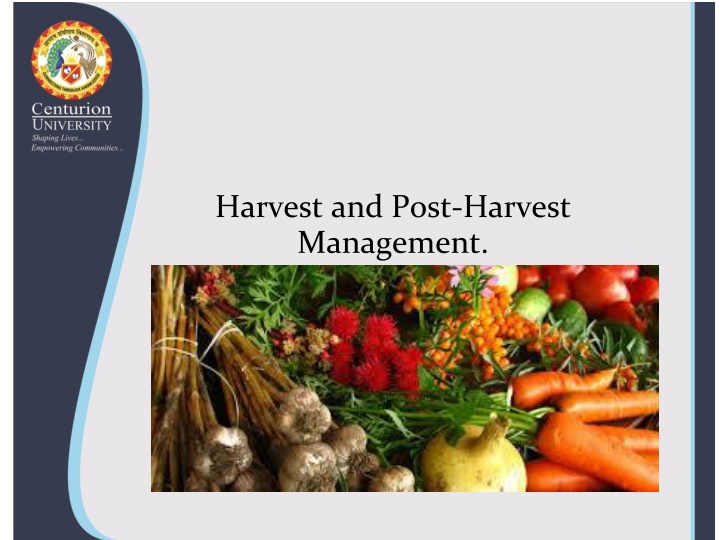
Effective Harvest and Post-Harvest Management Practices
Learn essential practices for maintaining produce quality during harvest and post-harvest stages. Discover tips on handling, cooling, storage, and more to preserve freshness and minimize decay for optimal product quality and market readiness.
Download Presentation

Please find below an Image/Link to download the presentation.
The content on the website is provided AS IS for your information and personal use only. It may not be sold, licensed, or shared on other websites without obtaining consent from the author. If you encounter any issues during the download, it is possible that the publisher has removed the file from their server.
You are allowed to download the files provided on this website for personal or commercial use, subject to the condition that they are used lawfully. All files are the property of their respective owners.
The content on the website is provided AS IS for your information and personal use only. It may not be sold, licensed, or shared on other websites without obtaining consent from the author.
E N D
Presentation Transcript
Harvest and Post-Harvest Management.
The inherent quality of produce can not be improved after harvest, only maintained for the expected window of time characteristic of the commodity. postharvest handling is knowing what this window of opportunity is under your specific conditions of production, season, method of handling, market. As a general following practices can help to maintain quality: Part of successful and distance approach, to the
Harvest during the coolest timeof the day to maintain low product respiration. Avoid unnecessary wounding, bruising, crushing, or damage equipment, or harvest containers. Shade harvested product in the field to keep it cool. Covering harvest bin sortotes with a reflective pad greatly reduces heat gain from the sun and reduces water loss and premature senescence. from humans,
If possible, move product in to a cold storage facility or post harvest cooling treatment as soon as possible. For some commodities, such as berries, tender green sand leafy herbs, one hour in the sun is too long. Don t compromise high quality product by inter mingling damaged, decayed, or decay-prone product in a bulk or packed unit. Only use cleaned and, as necessary, sanitized packing or transport containers.
Post harvest storage Room cooling: An insulated room or mobile container refrigeration units. Room cooling is slow compared with other options. Depending on the commodity, packing unit, and stacking arrangement the product may cool too slowly to prevent water loss, premature ripening, or decay. Forced air cooling: Fans are used in conjunction with a cooling room to pull cool air through packages of produce. Although the cooling rate depends on the air temperature and the rate of airflow, this method is usually 75 90% faster than room cooling. equipped with
Hydro cooling: Showering produce with chilled water is an efficient way to remove heat, and can serve as a means of cleaning at the same time. Use of a disinfectant in the water is essential and the some of the currently permitted products are discussed in the following section. Top or liquid icing: Icing is an effective method to cool tolerant commodities and is equally adaptable to small or large-scale operations. Vacuum cooling: Under vacuum, water with in the plant evaporates and removes heat from the tissues. This system works well for leafy crops Water may be sprayed on the produce prior to placing it vacuum.
Sanitation and water disinfection For operations, liquid sodium hypochlorite is the most common optimum anti microbial activity with a minimal concentration hypochlorite, the water pH must be adjusted to 6.5 to 7.5. both organic and conventional form used. For of applied
Importance temperature and shipping temperature Exposure of bagged or tightly wrapped produce to direct sunlight will rapidly raise the internal temperature. Specialized films, that create modified- atmospheres(MA) when sealed as a bag or pouch, are available form any produce items that have well-characterized low oxygen and elevated tolerances. Approved fruit and vegetable waxes are effective at reducing enhancing appearance. of optimum storage carbon dioxide water loss and
Symptoms of ethylene injury Russet spotting of lettuce Yellowing or loss of green color (ex. cucumbers, broccoli, kale, spinach) Increased toughness in turnips and asparagus spears Bitterness in carrots and parsnips Yellowing and abscission (dropping) of leaves in Brassicas
Softening, pitting, and development of off-flavor in peppers, summer squash, and watermelons. Browning and discoloration in eggplant pulp and seed Discoloration and off-flavor in sweet potatoes Increased ripening and softening of mature green tomatoes






















